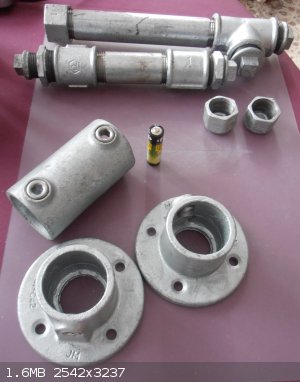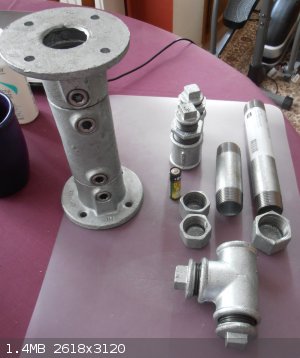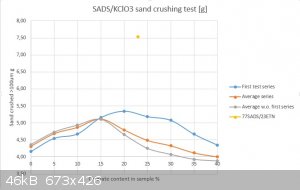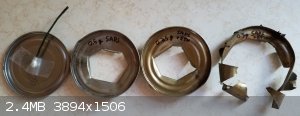| Pages:
1
..
5
6
7
8
9 |
nitro-genes
International Hazard
    
Posts: 1048
Registered: 5-4-2005
Member Is Offline
|
|
Quote: Originally posted by MineMan  |
They already pay $30 a cap... I don't think .1g of silver per cap would change that much... safety is king with the mining culture... they pride
themselves in it... on mine I worked at one could not enter a pickup bed truck without fall protection.
Remember, they only use 120mg of this stuff to fire PETN... we as armatures can make that amount for nearly 10 cents.
Accidents and investigations cost a lot... If a company like orica announced a switch to a infallible primary explosive, because of the strong safety
culture in the industry their stock would go up, and all competitors would have to follow.
[Edited on 4-3-2017 by MineMan] |
I was actually under the impression that commercially available NPED's had already completely replaced basting caps containing primaries, no?
|
|
|
MineMan
National Hazard
   
Posts: 996
Registered: 29-3-2015
Member Is Offline
Mood: No Mood
|
|
No,
All commercial caps still use dextrinated lead azide.
|
|
|
PHILOU Zrealone
International Hazard
    
Posts: 2893
Registered: 20-5-2002
Location: Brussel
Member Is Offline
Mood: Bis-diazo-dinitro-hydroquinonic
|
|
Quote: Originally posted by markx  | Quote: Originally posted by PHILOU Zrealone  | @Mineman, LL and markx,
Not only the price is important but also:
-the efficiency of reliable D2D (from shock, flame or electric spark)
and
-the initiating ability...for example how much Lead azide is required to set off TNT vs SADS? |
Of course....I was speaking on a generic level assuming comparable performance of a device/solution.
BTW Philou, how are your attempts on the sand crush test going? Any luck of seeing comparative data on the SADS mixtures? It would be really
interesting to compare the results 
My new coarser samples of limestone sand also arrived this week, but the granulometry is different at the upper end of grain size distribution. I
guess I will try a whole repetition of the series with a single batch of the new sand to limit the uncertainty factor and see what comes out of it.
|
I have bought a lot of material...
1°) I have to build my cells...
I can build 2 or 3 different size from 4/4 piping...but I also found an interesting possibility from modulable iron steel pieces to make support
structure or to make kinder playground...see pictures below.
2°) I have to have acces to my 0.001 mg scale into my appartement (must wait that my ex-grilfriend is leaving (maybe at the end of the month?))
3°) I have to make SADS the way you did it (warm at 80°C)...so eather I have to make AgNO3 from Ag jewellery and HNO3 or eather I need to have acces
to my old SADS stock and to my AgNO3 stock (into my appartement)...also need acces to my NaClO3 and KClO3.
4°) I have to cut all the pipes I have bought (Al, Cu, bronze) from various diameters at given various lenght with a pipe cutter, and drinking straws
(also various diameters and lenght)
5°) I have to build a screening plate (I have a thick grid with medium holes) and to test aquarium sand/gravels screening with it. The sand is
apparently some kind of silice (2-3mm diameter) with a dark glassy shine (garnet, glass?) anyway it is commercially available from AVEVE shops and
sold by 10kg (8L), I also have a finer white version (0,2-0,5 mm diameter) also 10kg.
Then I will be ready...for testing and reporting.
Here are the pictures of the pipes and metallic pièces for cell confection: (The AA battery is there for visual scaling purpose)
 
The conventional galva piping 4/4 is 2,7 cm internal diameter and 2,5mm wall thickness (thus external diameter 3,2 cm).
The larger "Flex Fit" pièces I have found (I have looked onto internet or into the provider website...but brand is nowhere to find???(*))
It is composed of 5mm wall thickness and 4,5 cm internal diameter...you can stick a pipe of suited lenght into it (4,5 cm external and 4,2
internal)...thus the total wall thickness would be 8mm for a cell of 4,2 internal diameter...easy to assemble and dissassemble with a simple hexagonal
screew (seen on the pictures) I just need to figure a way to close the ends with circular iron plates to put inside and perfectly fits the hole (I
think I will have to make it on my own and make it as thick as I want eventually by using multiple layers...in a way the minimum internal height of
the cell will be 18 cm... for a nominal testing cell volume of at least 210 cm3 
[Edited on 7-3-2017 by PHILOU Zrealone]
(*) I have found references by internet by using the code engraved onto the metallic pieces:
JM 131-C42 (A27)
Interclamp products
Raccords tubulaires
JM 149-C42 (C42 or D48)
Raccord tubulaire
[Edited on 7-3-2017 by PHILOU Zrealone]
PH Z (PHILOU Zrealone)
"Physic is all what never works; Chemistry is all what stinks and explodes!"-"Life that deadly disease, sexually transmitted."(W.Allen)
|
|
|
markx
National Hazard
   
Posts: 645
Registered: 7-8-2003
Location: Northern kingdom
Member Is Offline
Mood: Very Jolly
|
|
The cell project seems to be coming along nicely, Philou!  Hope you get
everything sorted out without too much trouble and can start experimenting.... Hope you get
everything sorted out without too much trouble and can start experimenting....
In the meantime I took one step further (or rather sideways) and made some experiments with SADS/ETN composite. This mix really packs some serious
sand crushing power. I figured that since ETN has a positive oxygen balance, then it should suit well for the purpose of boosting double salt
performance without rendering it too insensitive towards flame initiation. I did not have to dissapointed...first brisance results with 100mg samples
place the mix well above any previous KClO3 based results:

Calculating for the same amount of additional oxygen as with 15% KClO3 the mix came up with a 1/1 ratio of DS/ETN, which in practice turned out to be
passive towards flame initiation and could not be initiated with a fuse. Coming down with ETN content it was found that at about the ratio of 65/35
DS/ETN the mix became sensitive towards flame initiation in slightly compacted state, but was dead pressed very easily and after that became passive
again. At a composition of 77DS/23ETN the mix remained reasonably sensitive to flame also in the pressed state and exibited highly increased brisance.
The limestone sand was compacted so strongly by the test that it formed a thick solid layer on the walls of the cell and it had to be scraped off with
a metal spoon to perform sieve analysis.
P.S. The nitroester mixes were prepared by dissolving ETN with a few drops of acetone and then mixing into the DS in wet state to avoid too much
agitation.
[Edited on 7-3-2017 by markx]
Exact science is a figment of imagination.......
|
|
|
Laboratory of Liptakov
International Hazard
    
Posts: 1333
Registered: 2-9-2014
Location: Technion Haifa
Member Is Offline
Mood: cool.gif
|
|
It are perfect results... My reason was identical, but fear was bigger than making experiment. OK. If I read good, is possible under acetone making
mix 65 DS + 35 ETN. As output segment can be use pure ETN, for example 0,25g and as DDT segment described mix 65/35 with low -lower density, pressed
only on 3 Kg in cavity 6 mm, w. 0,25g. And insert Bickford fuse. It seems , that semi - NPED will be.... ...LL ...LL
Development of primarily - secondary substances CHP (2015) Lithex (2022) Brightelite (2023) Nitrocelite (2024)
|
|
|
markx
National Hazard
   
Posts: 645
Registered: 7-8-2003
Location: Northern kingdom
Member Is Offline
Mood: Very Jolly
|
|
Quote: Originally posted by Laboratory of Liptakov  | It are perfect results... My reason was identical, but fear was bigger than making experiment. OK. If I read good, is possible under acetone making
mix 65 DS + 35 ETN. As output segment can be use pure ETN, for example 0,25g and as DDT segment described mix 65/35 with low -lower density, pressed
only on 3 Kg in cavity 6 mm, w. 0,25g. And insert Bickford fuse. It seems , that semi - NPED will be.... ...LL ...LL |
For the sake of simplicity one can assume an effective mix of 80DS/20ETN by weight as a starting point. Weigh the components dry, add a few drops of
acetone and gently mix together until fairly dry. If left in wet state the mix will form a very hard cake that needs force to crumble or even break
off a mixing container's surface. Something that needs to be addressed with extreme caution. I do not know of the sensitivity or longevity of this mix
yet, so please proceed very cautiosly with any practical experiments.
[Edited on 28-3-2017 by markx]
Exact science is a figment of imagination.......
|
|
|
symboom
International Hazard
    
Posts: 1143
Registered: 11-11-2010
Location: Wrongplanet
Member Is Offline
Mood: Doing science while it is still legal since 2010
|
|
Silver acetylide double salt common plasicsizer
Is there a plasticsizer that could be added to make it malleable
Like clay using nitrocellulose or a common epoxy not sure which one
|
|
|
Laboratory of Liptakov
International Hazard
    
Posts: 1333
Registered: 2-9-2014
Location: Technion Haifa
Member Is Offline
Mood: cool.gif
|
|
SADS/ETN
Of course, plasticizer exist. Here is entire video : https://www.youtube.com/watch?v=dqUzKELQUM4
I mean, that is possible add ETN. According markx 80DS/20ETN and mix all together. Estimate + 8% plasticizer. However, is necessary try it very
carefully.
..... ....LL ....LL
Development of primarily - secondary substances CHP (2015) Lithex (2022) Brightelite (2023) Nitrocelite (2024)
|
|
|
symboom
International Hazard
    
Posts: 1143
Registered: 11-11-2010
Location: Wrongplanet
Member Is Offline
Mood: Doing science while it is still legal since 2010
|
|
Polyisobutylene
Is used in the mix would rubber cement be a good alternative
What application is there a source for this binder
|
|
|
Laboratory of Liptakov
International Hazard
    
Posts: 1333
Registered: 2-9-2014
Location: Technion Haifa
Member Is Offline
Mood: cool.gif
|
|
Basic preparation PIB: https://www.youtube.com/watch?v=euVUa7C5rAM
Development of primarily - secondary substances CHP (2015) Lithex (2022) Brightelite (2023) Nitrocelite (2024)
|
|
|
PHILOU Zrealone
International Hazard
    
Posts: 2893
Registered: 20-5-2002
Location: Brussel
Member Is Offline
Mood: Bis-diazo-dinitro-hydroquinonic
|
|
With SADS would be good to add a little CaCO3 (1-2% to fight acidity) then a mix of NG and ETN aside with NC...so you would get a plastic with a high
performance.
The NG/ETN will ensure low volatility and power...the NG will reduce the mp of ETN and so the mix will be more like a viscous oïl (and ensure some
plasticity); the NC will ensure holding the SADS particles into a one block.
The CaCO3 will ensure storage stability because nitric esters and HNO3 traces present into the SADS may present some unstability.
The % of NG/ETN and NC must be worked out for optimum properties...This will be of course much more powerful than any PIB/oïl plasticizer because
NG/ETN/NC is active binder.
PH Z (PHILOU Zrealone)
"Physic is all what never works; Chemistry is all what stinks and explodes!"-"Life that deadly disease, sexually transmitted."(W.Allen)
|
|
|
symboom
International Hazard
    
Posts: 1143
Registered: 11-11-2010
Location: Wrongplanet
Member Is Offline
Mood: Doing science while it is still legal since 2010
|
|
are these good Polyisobutylene sources the video that LL has that tape is been replaced mainly with silicone he is lucky off to figure out other
sources such as bike innertubes would work but they are halogenated polyisobutylene as I read on wikipedia I could be wrong. bladders from basket ball
or other sport balls and waterproof electrical tape wikipedia also states chewing gum now that would be an interesting source
Any ideas
[Edited on 31-3-2017 by symboom]
|
|
|
PHILOU Zrealone
International Hazard
    
Posts: 2893
Registered: 20-5-2002
Location: Brussel
Member Is Offline
Mood: Bis-diazo-dinitro-hydroquinonic
|
|
Quote: Originally posted by symboom  | are these good Polyisobutylene sources the video that LL has that tape is been replaced mainly with silicone he is lucky off to figure out other
sources such as bike innertubes would work but they are halogenated polyisobutylene as I read on wikipedia I could be wrong. bladders from basket ball
or other sport balls and waterproof electrical tape wikipedia also states chewing gum now that would be an interesting source
Any ideas
[Edited on 31-3-2017 by symboom] |
Rat/Bird glue is also mainly PIB.
PH Z (PHILOU Zrealone)
"Physic is all what never works; Chemistry is all what stinks and explodes!"-"Life that deadly disease, sexually transmitted."(W.Allen)
|
|
|
NedsHead
Hazard to Others
  
Posts: 409
Registered: 9-12-2014
Location: South Australia
Member Is Offline
Mood: No Mood
|
|
wouldn't the cheap self amalgamating tape on eBay contain PIB?
http://www.ebay.com.au/itm/282353071379?_trksid=p2055119.m14...
|
|
|
dave321
Harmless

Posts: 45
Registered: 22-11-2012
Member Is Offline
Mood: No Mood
|
|
it strikes me that sads produced using the 60c temperature method, <10%silver nitrate conc. and acidified with nitric acid,
would be quite usable as an effects detonator for film effects.
may be a good substitute for the d-80 and d-60 series bullet hits (which use lead styphnate) made by de lamare in the usa, as it would be much less
toxic.
also seems to have suitable handling characteristics when dry (excluding static).
any comments anyone ?
|
|
|
MineMan
National Hazard
   
Posts: 996
Registered: 29-3-2015
Member Is Offline
Mood: No Mood
|
|
yes dave. i think that would be the best option. Is there a market for that... as I have a comp that is even safer??
Feel free to PM be about SADS... I have made it several times... and am somewhat experienced with it
|
|
|
dave321
Harmless

Posts: 45
Registered: 22-11-2012
Member Is Offline
Mood: No Mood
|
|
mine man,
pm sent
|
|
|
MineMan
National Hazard
   
Posts: 996
Registered: 29-3-2015
Member Is Offline
Mood: No Mood
|
|
Sent you some tips as well.. we will figure out a good safe solution for your application together.
|
|
|
PHILOU Zrealone
International Hazard
    
Posts: 2893
Registered: 20-5-2002
Location: Brussel
Member Is Offline
Mood: Bis-diazo-dinitro-hydroquinonic
|
|
Yes SADS is detonating in minute amount with a loud report and is not strong enough to arm someone if there is a hard back plate behind the
charge...so it could indeed be used for special effect of bullet hit although maybe exploding too bright white vs styphnate...
[Edited on 2-6-2017 by PHILOU Zrealone]
PH Z (PHILOU Zrealone)
"Physic is all what never works; Chemistry is all what stinks and explodes!"-"Life that deadly disease, sexually transmitted."(W.Allen)
|
|
|
agent_entropy
Hazard to Self
 
Posts: 91
Registered: 17-7-2006
Location: U.S.
Member Is Offline
Mood: No Mood
|
|
Has anyone here experimented with, or is anyone aware of reported accounts, of adding acetone to the silver nitrate solution to increase the
solubility of acetylene? Since acetylene is often stored as a solution in acetone, this seems go me like a logical iteration of the experiments
concerning this substance.
Of course a nitric acidified solution would have to be dilute to avoid oxidizing the acetone.
|
|
|
PHILOU Zrealone
International Hazard
    
Posts: 2893
Registered: 20-5-2002
Location: Brussel
Member Is Offline
Mood: Bis-diazo-dinitro-hydroquinonic
|
|
Quote: Originally posted by agent_entropy  | Has anyone here experimented with, or is anyone aware of reported accounts, of adding acetone to the silver nitrate solution to increase the
solubility of acetylene? Since acetylene is often stored as a solution in acetone, this seems go me like a logical iteration of the experiments
concerning this substance.
Of course a nitric acidified solution would have to be dilute to avoid oxidizing the acetone. |
Good idea.
Depends if the aceton doesn't reduce the solubility of the AgNO3.
Into the not too wished case of a bad event...aceton would be a higher hazard...because of its flamability...a detonating stuff into a flamable
solvent (even if slightly diluted)...not a nice picture following me.
Depends also of the buy products between aceton and HNO3...as you mentionned both reacts and quite fast...into the mix nitro-, nitroso-,
nitronitroso-, dinitro-, trinitro- aceton and oxydation or hydrolysis products...some of those may form sensitive compounds with Ag(+)...some may even
precipitate metallic nano Ag or black Ag what would be bad news for SADS/SANC stability.
--> Thus must be tested and compared vs normal process to see if stability/sensitivity is equal, better or worst...same with power.
PH Z (PHILOU Zrealone)
"Physic is all what never works; Chemistry is all what stinks and explodes!"-"Life that deadly disease, sexually transmitted."(W.Allen)
|
|
|
agent_entropy
Hazard to Self
 
Posts: 91
Registered: 17-7-2006
Location: U.S.
Member Is Offline
Mood: No Mood
|
|
With the acetone... If silver isn't reduced to its metallic form it might (?) result in some new practically worthwhile morphological variants. If
the nonvolatile acetone oxidation products are included or occluded into the SADS it could help with the gas production problem.
|
|
|
PHILOU Zrealone
International Hazard
    
Posts: 2893
Registered: 20-5-2002
Location: Brussel
Member Is Offline
Mood: Bis-diazo-dinitro-hydroquinonic
|
|
Quote: Originally posted by agent_entropy  | | With the acetone... If silver isn't reduced to its metallic form it might (?) result in some new practically worthwhile morphological variants. If
the nonvolatile acetone oxidation products are included or occluded into the SADS it could help with the gas production problem.
|
To me would be much more beneficial to work with a dry (not too hygroscopic) amine salt like NH4ClO4.
It has already been proven (earlier into this tread) that SADS/SANC can be improved by addition of KClO3 up to 40% by weight...maximum power being
between 15 and 25%.
[Edited on 7-7-2017 by PHILOU Zrealone]
PH Z (PHILOU Zrealone)
"Physic is all what never works; Chemistry is all what stinks and explodes!"-"Life that deadly disease, sexually transmitted."(W.Allen)
|
|
|
agent_entropy
Hazard to Self
 
Posts: 91
Registered: 17-7-2006
Location: U.S.
Member Is Offline
Mood: No Mood
|
|
I tested some SADS with KClO3 and found it less than impressive (perhaps I should have mixed them more intimately using a few drops of water, then
dry).
I also tested some of the above mentioned SADS:ETN (80:20) and was absolutely shocked by the massive increase in apparent power as indicated on the
witness plates pictured below. I don't have a fancy sand-crushing cell, but the experiment below seems to demonstrate the relative brisance handily.
Small aluminum foil balls full of the stuff were prepared using approximately 0.17 g of aluminum foil each and each charge was provided with a length
of visco fuse. The test charges were then scotch taped to the center of a 15 oz food-can lid to prevent the spit of the fuse from propelling it off
center. Each test was rested gently atop some grass of length approximately 8cm and ignited. In the picture below, from right to left: A test
charge taped to its witness plate / 0.50g SADS / 0.25g SADS:ETN (80:20) / 0.50g SADS:ETN (80:20).

|
|
|
PHILOU Zrealone
International Hazard
    
Posts: 2893
Registered: 20-5-2002
Location: Brussel
Member Is Offline
Mood: Bis-diazo-dinitro-hydroquinonic
|
|
@ Agent_entropy,
Nice visual comparative testing 
PH Z (PHILOU Zrealone)
"Physic is all what never works; Chemistry is all what stinks and explodes!"-"Life that deadly disease, sexually transmitted."(W.Allen)
|
|
|
| Pages:
1
..
5
6
7
8
9 |